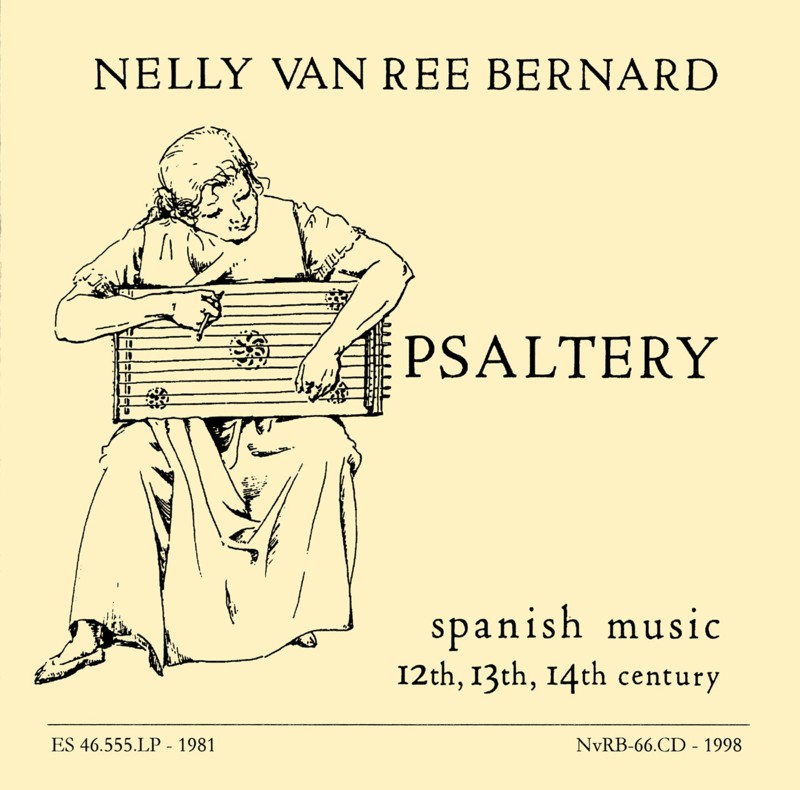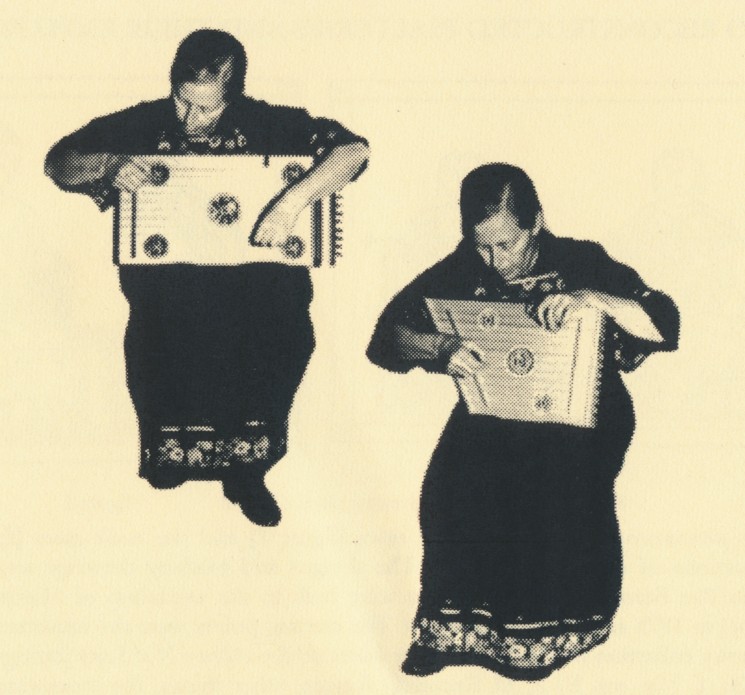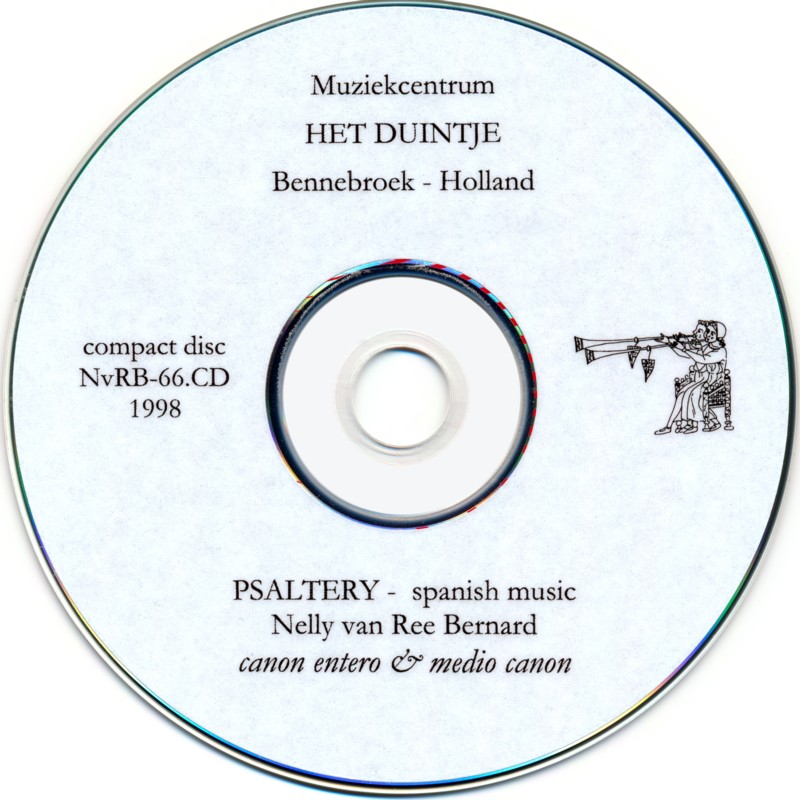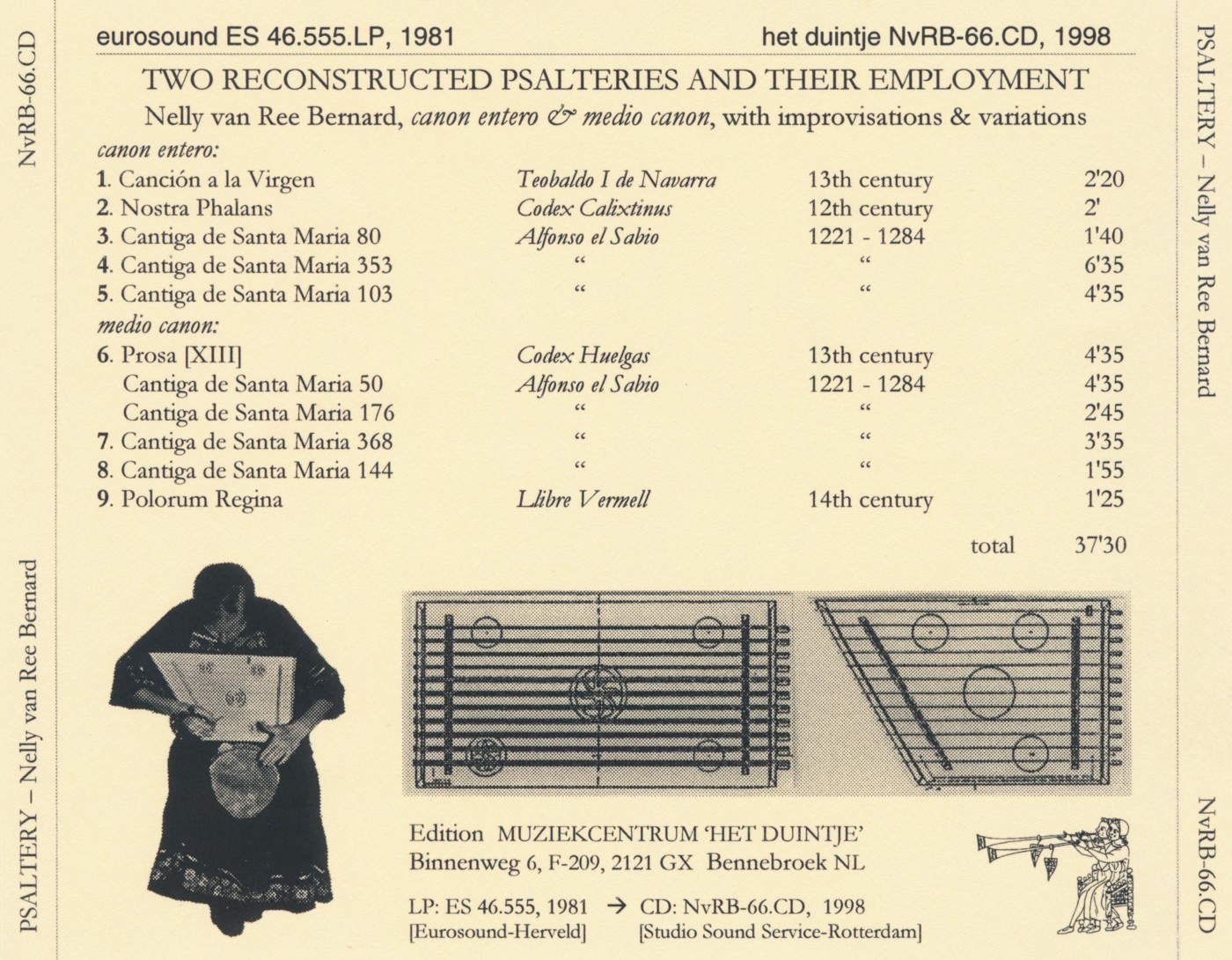
medieval.org | worldcat.org
discogs.com | mootube.ru
LP: ES 46.555 [Eurosound-Herveld], 1981
CD: NvRB-66.CD [Studio Sound Service-Rotterdam], 1998
[37:30]
Psaltery
/ Nelly van Ree Bernard
Spanish music ·
12th, 13th, 14th century
TWO RECONSTRUCTED PSALTERIES AND THEIR EMPLOYMENT

medieval.org |
worldcat.org
discogs.com |
mootube.ru
LP: ES 46.555 [Eurosound-Herveld], 1981
CD: NvRB-66.CD [Studio Sound Service-Rotterdam], 1998
[37:30]
Canon entero
1. Canción a la Virgen [2:20]
TEOBALDO I de Navarra,
13th century
[De grant travail et de petit esploit]
2. Nostra Phalans [2:00]
Codex Calixtinus,
13th century
cc 95
3. Cantiga de Santa Maria 80 [1:40]
ALFONSO el SABIO, 1221-1284
CSM 80
4. Cantiga de Santa Maria 353 [6:35]
ALFONSO el SABIO, 1221-1284
CSM 353
5. Cantiga de Santa Maria 103 [4:35]
ALFONSO el SABIO, 1221-1284
CSM 103
Medio canon
6.
Prosa [XIII] [4:35] Codex Huelgas, 13th century
Hu 62
[In sapiencia disponens omnia]
Cantiga de Santa Maria 50 [4:35]
ALFONSO el SABIO, 1221-1284
CSM 50
Cantiga de Santa Maria 176 [2:45]
ALFONSO el SABIO, 1221-1284
CSM 176
7. Cantiga de Santa Maria 368 [3:35]
ALFONSO el SABIO, 1221-1284
CSM 368
8. Cantiga de Santa Maria 144 [1:55]
ALFONSO el SABIO, 1221-1284
CSM 144
9. Polorum Regina [1:25]
Llibre Vermell de Montserrat,
14th century
LV 7

Nelly van Ree Bernard was born in the Netherlands in 1923 and grew up
in Spain, where she gained her piano diploma at Academia Marshall in
1945 [Barcelona]. She studied guitar with Alfredo Romea [Barcelona].
She finished her studies in interior design in 1949 [Amsterdam]. She
studied harpsichord with Jaap Spigt [Amsterdam] from 1960 onwards and
spent a year [1968/69] in India studying Hindustani music with Dr
Premlata Sharma [Varanasi]. After her return from India she gradually
changed from harpsichord to clavichord and she began to concentrate on
16th century Spanish music, greatly helped by Dr Santiago Kastner
[Lisbon]. She formed the vocal-instrumental ensemble MUSICA IBERICA and
she began to re-design 'lost' early instruments [various types of
psaltery and very early clavichords], which were built after her
working drawings by different instrument-makers in Germany and Holland.
She reconstructed the playing methods of the 'reborn' instruments
recording the different aspects in publications and on LPs, cassettes
and CDs. She has been giving lectures and courses on Hindustani music,
Early Iberian music and Sephardic music in the Netherlands and abroad.
Since 1966 she has been organizing concerts, lectures, exhibitions and
demonstrations of instruments, at her music centre HET DUINTJE
[Bennebroek, Holland], where about 70 European and non-European
instruments, including her own reconstructions [three clavichords and
eight psalteries], were permanently on show for visitors until 1993.
From 1986 to 1993 she has been a board member of HET NEDERLANDS
CLAVICHORD GENOOTSCHAP [The Dutch Clavichord Society, founded in 1986].
Besides in Holland, Nelly van Ree Bernard has presented musical
activities in Austria, Belgium, Canada, Germany, India, Italy, Norway,
Poland, Portugal, Spain, Sweden, Switzerland and the United States of
America.
April, 1998
Recording engineer: Ernest Scheerder,
EUROSOUND, Hen-eld-Holland, June 1980; Hervormde Kerk (church), Bennebroek-Holland
Photos: Marjel Hersman
Pendrawing on the cover: Tea van der Drift-Holtrust Nelly van Ree Bernard
Layout, cover & booklet: Nelly van Ree Bernard
Translations: John Kirkpatrick
Edition Muziekcentrum HET DUINTJE, Nelly van Ree Bernard
Binnenweg 6, F-209, 2121 GX BENNEBROEK, The Netherlands
Tel. +31.(0)23-584 61 26. Fax +31.(0)23-584 90 98
Books consulted for the notation:
— Anglés, H., Historia de la Música Medieval en Navarra, Diputación Foral de Navarra, Pamplona, 1970.
— Anglés, H., La Música de las Cantigas de Santa
María del Rey Alfonso el Sabio, II, Transcripción
Musical, Diputación Provincial de Barcelona, 1943.
— Anglés, H., La Música de las Cantigas ..., III, 2a
parte, sección II, Secuencias del Códice Musical de las
Huelgas, Diputación Provincial de Barcelona, 1958.
— Ursprung, O., Spanisch-Katalanische Liedkunst des 14. Jh.s, ZMW, 3. Heft, IV. Jg., 1921.

The two instruments played, the canon entero [figure 1] and the medio
canon [figure 2] are reconstructions of medieval psalteries. The
designs and working drawings were made by Nelly van Ree Bernard; the
instruments were built in the workshop of Martin Sassmann [Germany] in
1975 and 1977 respectively. The starting points were the miniatures
from the 13th century collection of Cantigas de Santa Maria del Rey
Alfonso X el Sabio [cantiga 80, f 96v, cantiga 50, f. 71v, ms. b.I.2,
El Escorial]. Among other things, the measuring of related instruments
in the Instrumental Museum in Brussels and the study of the range and
mode of the ca. 400 cantigas belonged to those preliminary studies made
before the actual drawings could be commenced. Both instruments have a
range of a tenth, diatonically tuned, wherein b flat as well as b
natural is present. The range of the rectangular psaltery is c - e ',
and that of the half-trapezoid c' - e''. The medio canon is singly
strung; the canon entero is strung in triplicate, except the four bass
notes which are strung in pairs These psalteries are plucked in a
vertical position. The right hand employs a bird's feather cut to form
a plectrum; the left hand plucks the bourdon tones or the
counter-melody with the fingertips.
Instrumental arrangements, improvisations and variations Nelly van Ree Bernard
Method of playing the canon entero
Position of the instrument and the arms: see the illustration on the cover.
Playing thechnique for the right hand: The strings are plucked with a quill in a downward direction. There are two techniques:
a. playing on one string of a course [2 or 3 strings for one note],
b. playing on all the strings of a course.
During playing, the right lower arm moves along the side of the instrument.
Playing technique for the left hand: The strings are plucked with the fingertips [not the nails] in a upward direction. There are two techniques:
a. playing on one string of a course,
b. playing on all the strings of a course.
The forefinger and middle finger are used alternately; the left lower
arm slides along the upper edge, if necessary across the damper
[lightly]; in plucking the strings in the lowest position [the highest
in tone], it may be advisable to shift along the side. Two-note chords
can be played with the left hand using the thumb and index or middle
finger.
The damper: The damper over
the left hand bridge is operated by the left hand; it can vary the tone
from 'reverberating' to completely 'damped off' [NB: the damper does
not appear in the miniature]
Harmonics: When the fingertips
of the left hand touch the strings lightly halfway, these strings being
at the same time plucked with the right hand, octave tones are heard.
Method of playing the medio canon
Considering that the medio canon is singly strung, the 'course' technique is rendered inapplicable here. In addition, the medio canon has no damper. This smaller instrument is tuned an octave higher than the canon entero.
For more information about the canon entero and the medio canon see the publication The Psaltery [mentioned under 'Notations'], pp. 20-43.

Sources
Teobaldo I de Navarra:
Teobaldo I, King of Navarra [Count of Champagne and Brie; 1201-1253]
was one of the most important French trouvères. 541 texts and
410 melodies of this poet and musician have been preserved which, as
far as can be ascertained, are of his own creation [No 1].
Codex Calixtinus: This 12th
century codex, also called Liber Sancti Jacobi, from the cathedral of
Santiago de Compostela is among the most important documents in the
history of the development of European polyphony. Here are to be found,
among other things, one three-part- and more than 20 two-part pieces
[No 2].
Alfonso el Sabio: Under the
guidance of King Alfonso X [king of Castile and Leon: 1252-1284], the
collection of Cantigas de Santa Maria del Rey Alfonso el Sabio was
compiled, probably with the assistance of Provençal as well as
Galico-Portuguese troubadours. The book [b.I.2, El Escorial] contains
more than 400 Cantigas [Nos 3, 4, 5, 6, 7, 8].
Codex Huelgas: This codex from
the monastery of Santa Maria la Real de Religiosas del Cister de las
Huelgas contains compositions with Latin texts for one voice as well as
for more than one. In the 13th and 14th centuries, the Huelgas
monastery was an important centre for Ars Antigua and Ars Nova
polyphony [No 6].
Llibre Vermell. In this 14th
century manuscript from the Montserrat monastery in Catalonia, along
with prayers, readings and sermons, one finds one-, two- and three-part
compositions, ten altogehther. According to a note in the margin, here
it is not a matter of liturgical but of popular religious music [No 9].
Notations
Notations of the recorded compositions as arranged for canon entero/medio canon
can be found in the following publication: Nelly van Ree Bernard, The
Psaltery — an annotated audio-visual review of different types of
psaltery, Frits Knuf Publishers, Buren The Netherlands, 1989 [pp.
124-1331; NvRB-47, ISBN 90-6027-609-4 [wrappers: book + cassette], and
ISBN 90-6027-610-8 [cloth: book + cassette].
